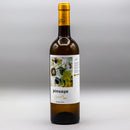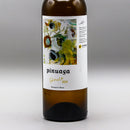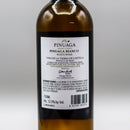Description
Food pairing: All sorts of entrees, sea foods, white fish as well as salads, pastas and tapas.
Soils/Vines: Grapes used for this wine are sourced from a single vineyard of 15 HA; Soils are mainly clay-limestone covered with layers of pebble stones.
Wine making: Sauvignon Blanc grapes are harvested manually during mid August in cases of 15 kg each. The must is fermented at low temperatures in small stainless steel tanks; remaining over fine lees during at least 2 months with several battonage before wine is bottled.
Ageing: To reinforce fruit and fresh aromas wine is un-oaked and aged over lees in tanks during several months, resulting in a Young and fun wine.
Valentin Pinuaga Salazar founded this small estate back in the 1960’s. Today the winery is run by Valentin and Esther Pinuaga - second and third generation of this family of traditional winemakers.
The 90 hectares of vineyards and the winery are located in Corral de Almaguer, Toledo, a privileged site 800 meters above sea level, and surrounded by Mediterranean oak forests. The continental climate, with pronounced changes in day-and-evening temperatures, boosts the unique personality of the land and enhances the quality of the vines. It favors the growth of autochthonous grape varieties, allowing the production of varietally-expressive wines. Amongst these grape varieties, Tempranillo and Merlot vines are grown, which are different in age, soil, altitude and orientation. Each vineyard is always vinified separately. The Tempranillo vines are bush trained as this is the best growing technique for the area. A bush vine is made up of irregular branches, growing directly from the soil and reaching up to 3.2 feet high. That enables the bunches to be well ventilated and spread out from each other. The soil is mainly clay-limestone. The grapes are all hand harvested (starting at 4am because of the heat), at very low yields of 2,500 kg/ha, and in small cases of 10kg. Choosing the right picking time is crucial. The vineyards are sampled up to three times per week. Detailed observations, such as the health of the vineyards, the physical condition of the seeds and skins, the ripeness of the berries and pips, together with lab analyses, enable to pick at optimum ripeness. Total production is around 100,000 bottles.
Farming/winemaking practices: Certified organic since 2010. Wild grass usually grows freely from the month of October until April and the vineyard borders are maintained with indigenous flora to enable beneficial insects to complete their life cycle. Fertilizing is kept down to a minimum, and only comes in the form of manure. Fungal sprays are essentially in the form of sulphur, and the treatment is done vine per vine.
Payment & Security
Your payment information is processed securely. We do not store credit card details nor have access to your credit card information.






